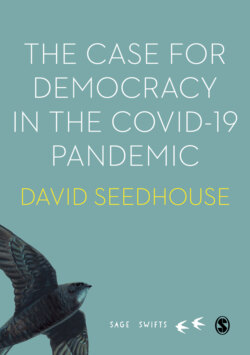Читать книгу The Case for Democracy in the COVID-19 Pandemic - David Seedhouse Dr. - Страница 12
На сайте Литреса книга снята с продажи.
2 Searching for Balance
ОглавлениеMany human beings – certainly very many millions – have been infected with a potentially fatal novel coronavirus which can cause a disease known as COVID-19. Governments around the world have restricted civil liberties to halt or slow its spread. Policy-makers claim to be ‘guided by the science’ and most insist that their measures – which in some countries have included laws to force people not to leave their homes for any reason for weeks – are ‘essential to the public health'.
While this reaction is understandable up to a point, there are so many unknowns and so many diverse social, economic and psychological factors in play, it is equally essential to ask whether such a radical response is proportionate: now and in the future.
The Spanish ‘flu of 1918 is estimated to have killed between 50 and 100 million people and has informed responses to influenza and other viral outbreaks ever since. There is genuine fear among academics and public health specialists that an outbreak on a similar scale could occur, which in part explains the extreme curtailment of liberty in 2020. Yet, COVID-19 is far less damaging than the Spanish ‘flu (although it is more damaging than other recent viruses):
Most people recover from Covid-19 within a week and cannot even be certain they had it, as they probably won't be tested. The advice is to stay home, rest and take paracetamol. In 80% of cases, that is the end of it. But NHS advice is that if the symptoms – mainly the dry cough, temperature and fatigue – have not gone by the end of a week, or they get worse, people should seek medical help. (14)
The impacted populations are not the same in these pandemics. COVID-19 almost entirely affects the elderly, whereas Spanish ‘flu affected the 20–40 age group (15).
Regardless of their virulence, epidemics cause considerable alarm among planners. In the UK, they sit at the top of ‘the National Risk Register of Civil Emergencies’ (16), rated ‘most catastrophic', a ranking shared only with major ‘terrorist events'. When viral outbreaks occur, experts in epidemiology, medicine and related sciences use modelling tools to predict their likely course. The scientists present what they call the ‘reasonable worst-case scenario', which is often a calamitous prediction (17). This places governments in an extremely difficult position: their leading scientists explain the potential damage from the outbreak; other governments around the world initiate radical measures to suppress or mitigate it; deliberately or accidentally, news and social media outlets create alarm and anxiety in the public. In such heated circumstances, how can ministers fail to follow the ‘expert advice', and conform to crowd expectations?
But is this ‘safety first’ approach really in the public interest? Is the professional expertise that informs decision-making in these circumstances sufficiently broad to achieve the most sane and practical balance?
Many thousands of deaths are of great concern. It is important to remember that behind the charts and statistics human lives are being ended tragically and prematurely. But the coronavirus is by no means the only or most significant cause of human tragedy – there are a great many other human concerns too. If we are to react optimally to the next pandemic, these need to be systematically and honestly addressed in balance with ‘public health emergencies', and more robust and democratic response mechanisms need to be put in place.
